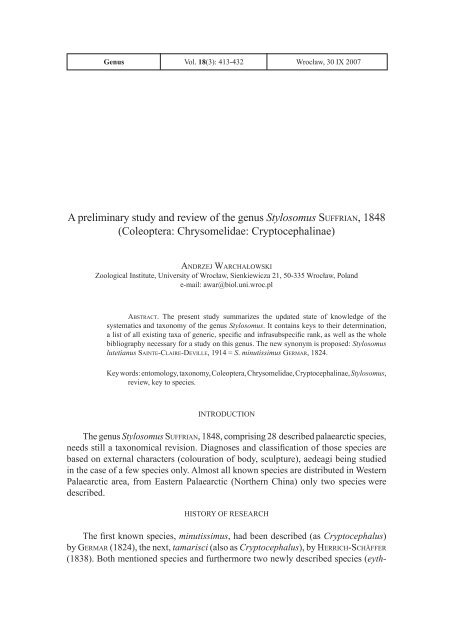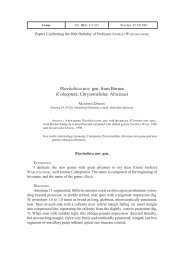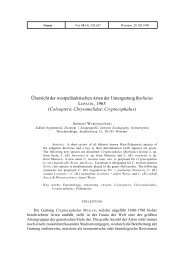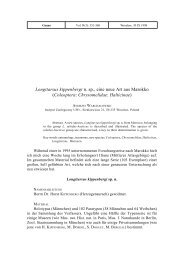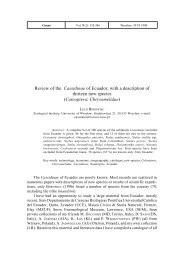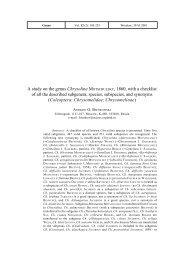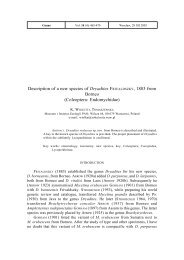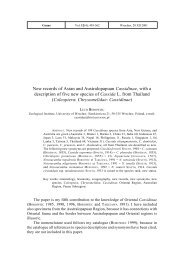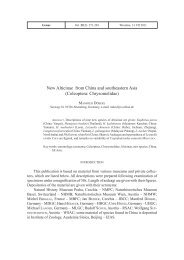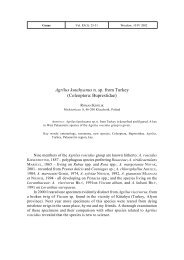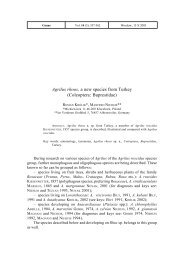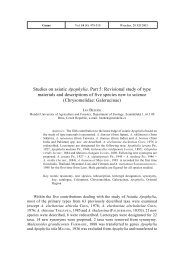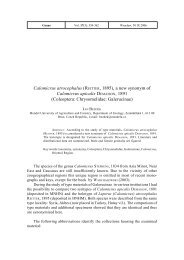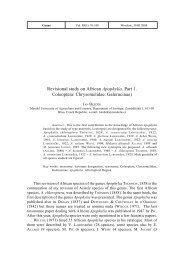A preliminary study and review of the genus Stylosomus SUFFRIAN ...
A preliminary study and review of the genus Stylosomus SUFFRIAN ...
A preliminary study and review of the genus Stylosomus SUFFRIAN ...
You also want an ePaper? Increase the reach of your titles
YUMPU automatically turns print PDFs into web optimized ePapers that Google loves.
Genus Vol. 18(3): 413-432 Wrocław, 30 IX 2007<br />
A <strong>preliminary</strong> <strong>study</strong> <strong>and</strong> <strong>review</strong> <strong>of</strong> <strong>the</strong> <strong>genus</strong> <strong>Stylosomus</strong> Suffrian, 1848<br />
(Coleoptera: Chrysomelidae: Cryptocephalinae)<br />
Andrzej WArchAłoWski<br />
Zoological Institute, University <strong>of</strong> Wrocław, Sienkiewicza 21, 50-335 Wrocław, Pol<strong>and</strong><br />
e-mail: awar@biol.uni.wroc.pl<br />
abStract. The present <strong>study</strong> summarizes <strong>the</strong> updated state <strong>of</strong> knowledge <strong>of</strong> <strong>the</strong><br />
systematics <strong>and</strong> taxonomy <strong>of</strong> <strong>the</strong> <strong>genus</strong> <strong>Stylosomus</strong>. It contains keys to <strong>the</strong>ir determination,<br />
a list <strong>of</strong> all existing taxa <strong>of</strong> generic, specific <strong>and</strong> infrasubspecific rank, as well as <strong>the</strong> whole<br />
bibliography necessary for a <strong>study</strong> on this <strong>genus</strong>. The new synonym is proposed: <strong>Stylosomus</strong><br />
lutetianus Sainte-claire-Deville, 1914 = S. minutissimus Germar, 1824.<br />
Key words: entomology, taxonomy, Coleoptera, Chrysomelidae, Cryptocephalinae, <strong>Stylosomus</strong>,<br />
<strong>review</strong>, key to species.<br />
InTrodUCTIon<br />
The <strong>genus</strong> <strong>Stylosomus</strong> Suffrian, 1848, comprising 28 described palaearctic species,<br />
needs still a taxonomical revision. diagnoses <strong>and</strong> classification <strong>of</strong> those species are<br />
based on external characters (colouration <strong>of</strong> body, sculpture), aedeagi being studied<br />
in <strong>the</strong> case <strong>of</strong> a few species only. Almost all known species are distributed in Western<br />
Palaearctic area, from Eastern Palaearctic (nor<strong>the</strong>rn China) only two species were<br />
described.<br />
HISTory <strong>of</strong> rESEArCH<br />
The first known species, minutissimus, had been described (as Cryptocephalus)<br />
by Germar (1824), <strong>the</strong> next, tamarisci (also as Cryptocephalus), by HerricH-ScHäffer<br />
(1838). Both mentioned species <strong>and</strong> fur<strong>the</strong>rmore two newly described species (eyth-
414 AndrZEj WArCHAłoWSKI<br />
rocephalus <strong>and</strong> ericeti) were grouped into a separate <strong>genus</strong> <strong>Stylosomus</strong> by Suffrian<br />
(1848). By <strong>the</strong> end <strong>of</strong> <strong>the</strong> first World War 20 <strong>Stylosomus</strong>-species were described <strong>and</strong><br />
some short comparative studies, usually on a few species from defined areas (abeille<br />
De Perrin 1877, rey 1883, Pic, 1909) were also done. In <strong>the</strong> years 1950-2006 eight<br />
fur<strong>the</strong>r species were described, few keys to species from limited areas (LopAtin, 1962,<br />
1977, PetitPierre, 2000 WArchAłoWski, 2003) were also published.<br />
Genus <strong>Stylosomus</strong> Suffrian, 1848<br />
<strong>Stylosomus</strong> Suffrian, 1848: 146 (species typica: Cryptocephalus tamarisci HerricH-ScHäffer, 1838, fasc.<br />
143, t. 24, first species listed).<br />
KEy To SUBgEnErA<br />
1. Primary puncturation <strong>of</strong> elytra arranged in regular rows, at most here <strong>and</strong> <strong>the</strong>re<br />
insignificantly confused ............................................................. <strong>Stylosomus</strong> s. str.<br />
−. Primary puncturation <strong>of</strong> elytra entirely or partly (in anterior part <strong>and</strong> along <strong>the</strong><br />
suture) r<strong>and</strong>omly scattered ................................................................................. 2.<br />
2. Claw tarsomere about 2 × longer than tarsomere 3, tarsi shorter than tibiae .........<br />
.......................................................................................................... Microsomus.<br />
−. Claw tarsomere 3-4 × longer than tarsomere 3, tarsi approximately as long as tibiae<br />
............................................................................................................ Microstilus.<br />
Sub<strong>genus</strong> Microsomus Burlini, 1957<br />
species typica: <strong>Stylosomus</strong> (Microsomus) Bechynei burlini, 1957: 62, monotypic.<br />
KEy To SPECIES<br />
1. Along fourth interval <strong>of</strong> elytra runs a slightly convex, in anterior part paler coloured<br />
costa. Pronotum narrowed anterad, with oblique impression near fore angles. Upper<br />
side brown or grey-brown, with small, irregular lightenings on elytra. Elytra<br />
sometimes darkened in apical half. general appearance as in plate 1, fig. 1. Aedeagus<br />
not studied. Length 2.0-2.7 mm. distributed in Kirgizstan <strong>and</strong> E Uzbekistan<br />
.......................................................................................... costatus LopAtin, 1962.<br />
−. Elytra without costae, pronotum without impressions ....................................... 2.<br />
2. Upper side with dense, scale-like, adpressed, silvery hairs, covering ground <strong>of</strong><br />
elytra <strong>and</strong> <strong>the</strong>ir sculpture. Upper side in female brown, vertex, pronotum <strong>and</strong> <strong>of</strong>ten<br />
a broad transverse b<strong>and</strong> in hind part <strong>of</strong> elytra pitchy. In male upper side darker,<br />
usually pitchy, blackish or black. Legs yellow with brown or blackish tarsi. general<br />
appearance as in plate 1, fig. 3. Aedeagus not studied. Length 2.2-2.9 mm (= bechynei<br />
burlini, 1957, hirsutus LopAtin, 1961). distributed in E Kazakhstan <strong>and</strong> W Mongolia<br />
................................................................................................. major breit, 1919.
EvIEW <strong>of</strong> THE gEnUS StyloSoMuS<br />
415<br />
−. Upper side covered with short, semierect or erect, thin, not very dense hairs, not<br />
covering ground <strong>of</strong> elytra ................................................................................... 3.<br />
3. Pronotum long, subquadrate. Colouration <strong>of</strong> upper side ra<strong>the</strong>r uniform, reddishbrown,<br />
pronotum <strong>and</strong> anterior part <strong>of</strong> elytra <strong>of</strong>ten slightly darkened, vertex <strong>and</strong> tarsi<br />
sometimes blackish. general appearance as in plate 1, fig. 2. Aedeagus as in figs 1,<br />
2, similarly shaped as in tamarisci (anti<strong>the</strong>sis 18), but anterior part <strong>of</strong> lamina dorsalis<br />
(in <strong>Stylosomus</strong> fused with operculum) distinctly broader <strong>and</strong> flagellum usually<br />
protruding.. Length 2.2-2.6 mm.. distributed in sou<strong>the</strong>rn Ukraine <strong>and</strong> in sou<strong>the</strong>rn<br />
russia ...................................................................... cylindricus MorAWitz, 1860.<br />
−. Pronotum transverse, at least 1.4 × broader than long. Upper side densely <strong>and</strong> ra<strong>the</strong>r<br />
finely punctured. Upper side rusty-brown, with darker, sometimes blackish, blurred<br />
spots, lateral <strong>and</strong> central area <strong>of</strong> elytra between humeral callus <strong>and</strong> midlength always<br />
paler than basal or preapical parts. general appearance as in plate 1, fig. 4. Aedeagus<br />
not studied. relatively large species, length 2.0-2.9 mm (= amoenus SaHlberG, 1913<br />
nec Pic, 1909, sublineatus SaHlberG, 1913, sahlbergi WinkLer, 1929). distributed in<br />
E Kazakhstan, Uzbekistan, Tadzhikistan <strong>and</strong> Kirgizstan ....... weberi reitter, 1905.<br />
Sub<strong>genus</strong> Microstilus Pic, 1950<br />
KEy To SPECIES<br />
1. Upper side entirely black or black with a pale spot on apex <strong>of</strong> elytra. ......... 2.<br />
–. Upper side brown or black with testaceous pattern ....................................... 5.<br />
2. Elytra covered with very sparse <strong>and</strong> short hairs, almost or entirely glabrous. Pronotum<br />
impressed in <strong>the</strong> middle <strong>and</strong> along posterior margin. Upper side black, femora <strong>and</strong> tibiae<br />
reddish, tarsi brown or blackish. Aedeagus as in minutissimus (couplet 4). Length<br />
1.6-2.2 mm. Leaves on Quercus. distributed in Iberian Peninsula, sou<strong>the</strong>rn france <strong>and</strong><br />
nor<strong>the</strong>rn Italy ........................................................................ ilicicola Suffrian, 1848.<br />
−. Elytra covered with distinct, semierect hairs, partly arranged in longitudinal rows<br />
............................................................................................................................. 3.<br />
1-6 (orig.). Aedeagus in dorsal <strong>and</strong> lateral view: 1, 2 − <strong>Stylosomus</strong> (Microsomus) cylindricus, 3, 4 − S.<br />
(Microstilus) ericeti, 5, 6 − S. (M.) minutissimus
416 AndrZEj WArCHAłoWSKI<br />
3. W Mediterranean species .................................................................................. 4.<br />
−. Species from C. Asia. Pronotum relatively long, <strong>the</strong> ratio breadth/length less than 1.5<br />
×. remaining external characters as in rugithorax (anti<strong>the</strong>sis 4). general appearance<br />
as in plate 1, fig. 5. Aedeagus not studied. Length 1.8-2.6 mm. distributed in Kazakhstan<br />
<strong>and</strong> Uzbekistan ....................................................................... ater LopAtin, 1962.<br />
4. Body very small. Pronotum with one transverse, shallow impression along posterior<br />
margin only. Upper side black, femora <strong>and</strong> tibiae reddish, tarsi brown or blackish.<br />
Aedeagus as in figs 5, 6. Length 1.2-1.5 mm. (= depilis abeille, 1877, lutetianus<br />
Sainte-claire Deville, 1914, see chapter „<strong>review</strong> <strong>of</strong> species“). variation: apex<br />
<strong>of</strong> elytra pale (ab. terminalis fuente, 1907). nor<strong>the</strong>rn populations (from france),<br />
described as lutetianus Sainte-claire Deville, 1914, characterized by more distinct<br />
pubescence <strong>of</strong> upper side, are <strong>of</strong>ten considered as a distinct species. distributed in<br />
S Europe from Portugal <strong>and</strong> france to Balkan Peninsula, reported also from nW<br />
Africa .................................................................. minutissimus (Germar, 1823).<br />
−. Larger, body coloured as in ilicicola (couplet 2). ratio breadth/length <strong>of</strong> pronotum<br />
more than 1.5. Upper side ra<strong>the</strong>r strongly punctured. In aedeagus (figs 7, 8) tubular<br />
part very short, about 1.5 × longer than broad, with two longitudinal impressions<br />
dorsally. Length 1.8-2.2 mm. distributed in S france, Pyrenees <strong>and</strong> n Spain<br />
...................................................................................... rugithorax abeille, 1877.<br />
5. Species described from C Asia. Body somewhat stout, elytra covered with sparse <strong>and</strong><br />
short hairs, r<strong>and</strong>omly <strong>and</strong> ra<strong>the</strong>r finely punctured. Upper side pale reddish-brown, on<br />
elytra undefined large brightenings just before midlength <strong>and</strong> in apical part. general<br />
appearance as in plate 1, fig. 7. Aedeagus not studied. Length 2.0-2.6 mm.distributed<br />
in mountains <strong>of</strong> Tadzhikistan ............................................. tadzhicus LopAtin, 1965.<br />
−. W Mediterranean species ................................................................................... 6.<br />
6. Posterior margin <strong>of</strong> pronotum <strong>and</strong> anterior margin <strong>of</strong> elytra black <strong>and</strong> strongly elevated,<br />
forms two approached parallel ridges. Upper side brown or blackish brown with<br />
testaceous pattern. general appearance as in plate 1, fig. 6. Aedeagus as in figs 3, 4.<br />
Length 1.8-2.4 mm. (= bituberculatus desbrochers, 1870, constrictus ScHaufuSS,<br />
1861). distributed in Iberian Peninsula ................................... ericeti Suffrian, 1851.<br />
7-12 (orig.). Aedeagus in dorsal <strong>and</strong> lateral view: 7, 8 − S. (Microstilus) rugihorax, 9, 10 − <strong>Stylosomus</strong><br />
(<strong>Stylosomus</strong>) arnoldi, 11, 12 − S. (S.) bipartitus
EvIEW <strong>of</strong> THE gEnUS StyloSoMuS<br />
417<br />
–. Margins <strong>of</strong> pronotum <strong>and</strong> elytra nowhere particularly strong elevated. Upper side<br />
blackish, partly (anterior part <strong>of</strong> head, borders <strong>of</strong> pronotum narrowly, elytra at basis<br />
<strong>and</strong> largely at apex) testaceous. Male unknown. Length 2.0 mm. described from<br />
Morocco ............................................................................ marocanus Pic, 1950.<br />
Sub<strong>genus</strong> <strong>Stylosomus</strong> s. str.<br />
KEy To SPECIES<br />
1. E Palaearctic species .......................................................................................... 2.<br />
−. W Palaearctic species ......................................................................................... 3.<br />
2. Upper- <strong>and</strong> underside entirely black, sometimes with weak metallic shine. femora <strong>and</strong><br />
tibiae yellowish, tarsi darkened, antennomeres 1-4 or 1-5 yellow, remaining blackish.<br />
Primary puncturation <strong>of</strong> elytra very regular. general appearance as in plate 2, fig. 16.<br />
Aedeagus not studied. Length 2.1-2.4 mm (= sinensis LopAtin, 1956). distributed<br />
in n China (Kansu) <strong>and</strong> Mongolia ................................. submetallicus cHen, 1941.<br />
−. Upper- <strong>and</strong> underside never entirely black Upper side yellowish to reddish-brown,<br />
except basal margins <strong>of</strong> elytra <strong>and</strong> pronotum. Elytra finely punctured, ra<strong>the</strong>r densely<br />
covered with adpressed or subadpressed hairs, arising not only from primary punctures,<br />
but also from intervals. Aedeagus not studied. Length 2.0-2.2 mm. described<br />
from nE China (Suiyuan, Hopei) ........................................ vestitus cHen, 1941.<br />
3. Upper side distinctly bicolorous: head <strong>and</strong> pronotum reddish, elytra black. vertex<br />
laterally brown, legs orange reddish with piceous or black tarsi. general appearance<br />
as in plate 1, fig. 9. Apex <strong>of</strong> aedeagus (figs 11, 12) obtusely rounded, on both sides<br />
<strong>of</strong> opening small, tooth-like broadenings. Length 1.7-2.2 mm. distributed in Algeria<br />
................................................................................... bipartitus fairmaire, 1867.<br />
–. Body differently coloured .................................................................................. 4.<br />
4. general appearance as in phot. 10. In male on both sides <strong>of</strong> scutellum a brown or<br />
blackish spot, in middle <strong>of</strong> elytra a broad, jagged, transverse patch. Pronotum usually<br />
brownish with two great, fulvous spots in posterior part. In female dark pattern <strong>of</strong><br />
upper side reduced, blurred <strong>and</strong> pale. Abdomen in female testaceous, in male dark<br />
brown or blackish. Aedeagus as in figs 13, 14. Length 2.2-2.5 mm (male) to 2.4-2.7<br />
mm (female). distributed in Algerian subdesert area ...... biskrensis rey, 1883.<br />
–. Upper side differently coloured ........................................................................ 5.<br />
5. At least anterior part <strong>of</strong> elytra entirely black. Pronotum <strong>of</strong>ten with pale area along<br />
hind margin or entirely black. Upper side <strong>of</strong> body generally black, clypeus <strong>and</strong><br />
sometimes anterior part <strong>of</strong> frons pale, hind part <strong>of</strong> pronotum <strong>and</strong> apex <strong>of</strong> elytra <strong>of</strong>ten<br />
lightened, legs yellow with black or blackish tarsi. Length <strong>of</strong> body 1.7-2.2 mm. general<br />
appearance as in plate 1, fig.8. Aedeagus as in figs 9, 10. described from Tunisia<br />
............................................................................... arnoldi WArchAłoWski, 2006.<br />
–. Upper side differently coloured ......................................................................... 6.<br />
6. Body entirely reddish fulvous, with two blackish transversal stripes on elytra:<br />
anterior stripe (narrower) behind scutellum, posterior (broader) behind middle.
418 AndrZEj WArCHAłoWSKI<br />
Both stripes <strong>of</strong>ten divided into several little spots. Aedeagus not studied. Length<br />
1.9-2.3 mm. distributed in <strong>the</strong> Canary Isl<strong>and</strong>s ........... biplagiatus WoLLAston, 1864.<br />
–. Body differently coloured ................................................................................. 7.<br />
7. Body slightly bicoloured: head, pronotum <strong>and</strong> underside dark brown or blackish,<br />
elytra testaceous without distinct dark pattern, tarsi usually darkened. Body small<br />
<strong>and</strong> relatively narrow. Similar to darker coloured nigrifrons (couplet 10), but body on<br />
average smaller <strong>and</strong> fine reticulation <strong>of</strong> upper side distinct. general appearance as in<br />
plate 2, fig. 14. Aedeagus not studied. Length 1.5-1.9 mm. described from Algeria<br />
............................................................................................... macer WeiSe, 1882.<br />
–. Body not bicoloured, but usually pale fulvous with variable brownish or blackish<br />
pattern on vertex, pronotum <strong>and</strong> elytra, tarsi <strong>of</strong>ten darkened or blackish .......... 8.<br />
8. Head <strong>and</strong> pronotum considerably more densely haired than elytra. Elytral pattern<br />
relatively pale, brownish. Sternum in <strong>the</strong> middle, tarsi <strong>and</strong> sometimes tibiae at <strong>the</strong><br />
end blackish or black. Length 2.0-2.8 mm. See pubescens, couplet 16.<br />
–. Head <strong>and</strong> pronotum not or slightly more densely haired than elytra ................. 9.<br />
9. Body ra<strong>the</strong>r slender. In <strong>the</strong> middle <strong>of</strong> elytron interstices 4-6 not broader than<br />
diameter <strong>of</strong> punctures. Sternum blackish, abdomen fulvous. Colouring <strong>of</strong> upper<br />
side relatively pale, black pattern usually limited to a narrow sutural stripe only.<br />
Aedeagus as in figs 21, 22. Length 1.8-2.3 mm. variations: suture not darkened,<br />
on hind part <strong>of</strong> vertex two blackish spots (ab. notaticeps Pic, 1914); a dark form:<br />
underside blackish, sutural stripe broad, on pronotum a few dark spots (ab. sidonius<br />
Pic, 1913). distributed in near East <strong>and</strong> Asia Minor ..... subelongatus Pic, 1913.<br />
–. Body not distinctly slender. In <strong>the</strong> middle <strong>of</strong> elytron interstices 4-6 usually slightly<br />
broader than diameter <strong>of</strong> punctures ................................................................. 10.<br />
10. Pronotum long, its lateral margins very feebly rounded, almost straight, elytra 1.9-<br />
2.2 × longer than pronotum. Body pale coloured, pronotum slightly darker than<br />
elytra, upper side without dark pattern, rarely on anterior part <strong>of</strong> pronotum large,<br />
blurred darkening only. vertex in male black, in female pitchy, <strong>the</strong> dark colour usually<br />
encroaches on frons, in male <strong>of</strong>ten reaching to its anterior margin. ground reti-<br />
13-18 (orig.). Aedeagus in dorsal <strong>and</strong> lateral view: 13, 14 − S. (<strong>Stylosomus</strong>) biskrensis, 15, 16 − S. (S.)<br />
corsicus, 17, 18 S. (S.) erythrocephalus
EvIEW <strong>of</strong> THE gEnUS StyloSoMuS<br />
419<br />
culation <strong>of</strong> upper side very shallow <strong>and</strong> indistinct. Apex <strong>of</strong> claw tarsomere <strong>and</strong> claws<br />
blackish. general appearance as in plate 2, fig. 15. Aedeagus as in figs 19, 20. Length<br />
1.9-2.5 mm (= nigrifrons fleiScHer, 1909 nec Pic, 1909). distributed in Transcaspia<br />
from Turkmenia to E Uzbekistan ........................................ nigrifrons Pic, 1909.<br />
−. Pronotum shorter, its lateral margins more rounded, elytra at least 2.4 × longer<br />
than pronotum .................................................................................................. 11.<br />
11. Colouring <strong>of</strong> body usually very light, pale fulvous or pale testaceous, darkened are:<br />
abdomen in male, five apical antennomerons, apical part <strong>of</strong> tarsi <strong>and</strong> sometimes sternum<br />
only (see also niloticus, couplet 15). Exterior interstices <strong>of</strong> elytra strongly convex,<br />
covered with hairs shorter than double diameter <strong>of</strong> punctures. general appearance<br />
as in plate 2, fig. 13. Aedeagus not studied. Length 1.6-2.3 mm. variations: hind<br />
part <strong>of</strong> vertex, suture <strong>and</strong> tarsi darkened (ab. obscuritarsis Pic, 1914), distributed<br />
in Balcan Peninsula, Ukraine <strong>and</strong> sou<strong>the</strong>rn russia. .............. flavus marSeul, 1875.<br />
–. Colouring <strong>of</strong> body darker, upper side usually with brownish or blackish pattern....................................................................................................................<br />
12.<br />
12. Head <strong>and</strong> pronotum entirely reddish, elytra pale testaceous with a black, in hind<br />
part suddenly shortened sutural stripe. Aedeagus as in figs 17, 18. Length 1.6-2.0<br />
mm. described from Mesopotamia .................. erythrocephalus Suffrian, 1853.<br />
−. Head darkened on vertex or on vertex <strong>and</strong> frons, except in immature or rare entirely<br />
pale specimens ................................................................................................. 13.<br />
13. Anterior margin <strong>of</strong> aedeagus with a small, sharp, almost dentiform or spine-like lamella.<br />
External characters as in tamarisci (anti<strong>the</strong>sis 18) or biskrensis (couplet 4), but<br />
ground colour <strong>of</strong> upper side more rusty <strong>and</strong> dark pattern on elytra more blurred. general<br />
appearance as in plate 2, fig. 11. Aedeagus as in figs 15, 16. Length 1.7-2.1 mm.<br />
described from Corsica, known also from Provence <strong>and</strong> Sicily, distributed probably<br />
round <strong>of</strong> Tyrrhenian Sea. ....................................................... corsicus rey, 1883.<br />
−. Anterior margin <strong>of</strong> aedeagus obtusely cut, rounded or broadly sharpened, never<br />
with small, sharp lamella ................................................................................. 14.<br />
14. Species from Mesopotamia, near East <strong>and</strong> Egypt. Upper side generally pale, dark<br />
pattern absent or brownish ............................................................................... 15.<br />
−. Species from o<strong>the</strong>r area ................................................................................... 17.<br />
15. Species described from Egypt. External characters correspond with pale forms<br />
<strong>of</strong> tamarisci (anti<strong>the</strong>sis 18). Aedeagus not studied. Two colour aberrations were<br />
described: Body almost entirely pale (ab. tournieri Pic, 1909), on each elytron<br />
two darker spots at base <strong>and</strong> one spot behind middle (ab. multinotata Pic, 1909).<br />
Known from Egypt only, in opinion <strong>of</strong> some authors a race <strong>of</strong> tamarisci (anti<strong>the</strong>sis<br />
18) ................................................................................. niloticus Suffrian, 1857.<br />
−. Species from near East (S Turkey, Mesopotamia) .......................................... 16.<br />
16. Pronotum covered with hairs more densely than elytra Length 2.0-2.8 mm. External<br />
characters as in flavus (couplet 11). Aedeagus not studied. described from Mesopotamia,<br />
perhaps conspecific with subelongatus ....................... pubescens Pic, 1913.<br />
−. Pronotum not distinctly more densely pubescent than elytra. Similar to flavus<br />
(couplet 11), but more slender, intervals <strong>of</strong> primary elytral punctures narrower.<br />
See subelongatus, couplet 9.
420 AndrZEj WArCHAłoWSKI<br />
17. Species from Medirerranean area. Elytra under 2.5 × longer than pronotum<br />
........................................................................................................................... 18.<br />
−. Species from Transcaspia. Elytra over 2.6 × longer than pronotum. relatively large<br />
species, body length over 3.0 mm .................................................................... 19.<br />
18. In typical form pronotum with very weak darkenings only, almost entirely pale, on<br />
elytra black colour forms x-like pattern. general appearance as in plate 2, fig. 18. Aedeagus<br />
in dorsal view almost parallel, on apex slightly narrowed <strong>and</strong> transversely cut,<br />
flagellum shortly protruding; in lateral view gently bent, towards apex not thickened,<br />
but ra<strong>the</strong>r somewhat flattened. distributed in nW Algeria, Morocco <strong>and</strong> S Spain<br />
................................................................................................. xsignum Pic, 1899.<br />
−. In typical form black colour does not form an x-like pattern. general appearance<br />
as in plate 2, fig. 17. Apex <strong>of</strong> aedeagus (figs 23, 24) not rounded, but less or more<br />
shortly, obtusely triangular, anterior part <strong>of</strong> lamina dorsalis relatively narrow, about<br />
2 × narrower than <strong>the</strong> breadth <strong>of</strong> tubular part. Tubular part in lateral view thickened<br />
towards apex. Exterior interstices <strong>of</strong> elytra ra<strong>the</strong>r flattened, covered with hairs longer<br />
than double diameter <strong>of</strong> punctures. In typical form upper side pale testaceous with<br />
two brownish spots on anterior part <strong>of</strong> pronotum <strong>and</strong> with blackish sutural stripe<br />
dilated in scutellar area. Tarsi <strong>and</strong> sternum blackish, abdomen in female testaceous,<br />
in male dark brown or blackish. Length 1.6-2.3 mm. forms numerous colour variations<br />
(see <strong>review</strong> <strong>of</strong> species) distributed widely in western part <strong>of</strong> Mediterranean<br />
area from Morocco to dalmatia. <strong>and</strong> ?fur<strong>the</strong>r easterly to Central Asia (see remark to<br />
S. flavus, couplet 11) ........................................ tamarisci (HerricH-ScHäffer, 1838).<br />
19. Length <strong>of</strong> body over 3.0 mm (male about 3.0 mm, female about 3.4 mm). Pronotum<br />
<strong>and</strong> elytra dark brown or pitchy, margined with yellowish.Aedeagus not studied.<br />
described from Kirgizstan ....................................................... cheni LopAtin, 1962.<br />
−. Body on average shorter. Upper side pale, testaceous or pale rusty-brown, on pronotum<br />
<strong>of</strong>ten two blackish spots. Pronotum relatively short <strong>and</strong> broad. Puncturation<br />
<strong>of</strong> upper side very strong. general appearance as in phot. 12. Aedeagus not studied.<br />
Length 2.6-3.0 mm. distributed in SE Kazakhstan, E Uzbekistan <strong>and</strong> Kirgizstan<br />
.............................................................................................. fausti reitter, 1894.<br />
19-24 (orig.). Aedeagus in dorsal <strong>and</strong> lateral view: 19, 20 − S. (<strong>Stylosomus</strong>) nigrifrons, 21, 22 - S. (S.) subelongatus,<br />
23, 24 − S. (S.) tamarisci
Microsomus burlini, 1957: 61.<br />
rEvIEW <strong>of</strong> THE gEnUS StyloSoMuS<br />
rEvIEW <strong>of</strong> SPECIES<br />
Sub<strong>genus</strong> Microsomus Burlini, 1957<br />
Species typica: <strong>Stylosomus</strong> (Microsomus) bechynei burlini, 1957: 62, by<br />
original designation.<br />
<strong>Stylosomus</strong> (Microsomus) costatus loPatin, 1962<br />
<strong>Stylosomus</strong> (Microsomus) costatus LopAtin, 1962: 50.<br />
421<br />
Terra typica: valley <strong>of</strong> river Kugart (Kirgizstan).<br />
Material examined: Kirgizstan, valley <strong>of</strong> river Kugart, 27.05.1925, 1 ♂, 2 ♀,<br />
leg. dobrzhanskij.<br />
<strong>Stylosomus</strong> (Microsomus) cylindricus Morawitz, 1860<br />
<strong>Stylosomus</strong> cylindricus MorAWitz, 1860: 301.<br />
Terra typica: vicinity <strong>of</strong> Krasnoarmeysk (Sarepta), russia.<br />
Material examined: Ukraina (Cherson), Skadovsk, 15.08.1969, 3 ♂, 6 ♀, leg.<br />
v. dolin.<br />
<strong>Stylosomus</strong> (Microsomus) major Breit, 1918<br />
<strong>Stylosomus</strong> major breit, 1919: 118.<br />
<strong>Stylosomus</strong> bechynei burLini, 1957: 62.<br />
<strong>Stylosomus</strong> hirsutus LopAtin, 1961: 97.<br />
bechynei = hirsutus = major: LopAtin, 1977<br />
Locus typicus: Imam Baba (Transcaspia)<br />
Material examined: Tadzhikistan, protected area “Tigrovaya balka”, 20. 04.<br />
1961, 2 ♀, leg. I.K. Lopatin.<br />
<strong>Stylosomus</strong> (Microsomus) weberi reitter, 1905<br />
<strong>Stylosomus</strong> Weberi reitter, 1905: 94.<br />
<strong>Stylosomus</strong> Weberi var. amoenus Pic, 1909: 154.<br />
<strong>Stylosomus</strong> amoenus SaHlberG, 1913: 73, nec Pic, 1909.<br />
<strong>Stylosomus</strong> sublineatus SaHlberG, 1913: 75.<br />
<strong>Stylosomus</strong> sahlbergi WinkLer, 1929: 1245, nomen novum pro amoenus SaHlberG, 1913, nec Pic, 1909.<br />
sublineatus = sahlbergi = amoenus = weberi: LopAtin, 1977.<br />
Terra typica: Transcaspia.
422 AndrZEj WArCHAłoWSKI<br />
Material examined: Kirgizstan, valley <strong>of</strong> river naryn ad Tazhmyr, 1.04.1979,<br />
1 ♂, 2 ♀, leg. Tadzhibaev.<br />
Sub<strong>genus</strong> Microstilus Pic, 1950<br />
Microstylus rey, 1883: 314, nec ScHönHerr, 1847: 15 (Curculionidae).<br />
Microstilus Pic, 1950: 94.<br />
Stylomicrus PetitPierre <strong>and</strong> ALonso-zArAzAgA, 2000: 247.<br />
Species typica: <strong>Stylosomus</strong> (Microstilus) marocanus Pic, 1950: 94, monotypic.<br />
<strong>Stylosomus</strong> (Microstylus) ater LopAtin, 1962: 51.<br />
<strong>Stylosomus</strong> (Microstilus) ater loPatin, 1962<br />
Locus typicus: Aktash, Karzhantau range, Uzbekistan.<br />
Material examined: Chervak, 80 km nE <strong>of</strong> Taschkent, Uzbekistan, 12.05.1989,<br />
1 ♀, leg. L. Behne.<br />
<strong>Stylosomus</strong> (Microstilus) ericeti Suffrian, 1851<br />
<strong>Stylosomus</strong> ericeti Suffrian, 1851: 653.<br />
<strong>Stylosomus</strong> bituberculatus desbrochers DeS Loges, 1870: 169.<br />
<strong>Stylosomus</strong> constrictus ScHaufuSS, 1861: 92.<br />
bituberculatus = ericeti: marSeul, 1875: 298.<br />
constrictus = ericeti: marSeul, 1875: 299.<br />
Locus typicus: Montserrat, Catalonia (Spain).<br />
Material examined: mountains Sierra nevada, Spain, 24.06.1989, 2 ♀, leg. g.<br />
Bastazo <strong>and</strong> j. vela; ibidem, 23.06.1990, 1 ♂, 1 ♀, leg. j. vela.<br />
<strong>Stylosomus</strong> ilicicola Suffrian, 1848: 151.<br />
<strong>Stylosomus</strong> (Microstilus) ilicicola Suffrian, 1848<br />
Locus typicus: vicinity <strong>of</strong> Marseille, france.<br />
Material examined: jimena de la frontera, Spain (Cadiz), 29.05.1992, 2 ♂, 3<br />
♀, leg. A. Warchałowski; villanueva del Trabuco, Spain (Málaga), 14.05.1988, 1 ♂,<br />
3 ♀, leg. A. Warchałowski.<br />
<strong>Stylosomus</strong> (Microstilus) marocanus Pic, 1950<br />
<strong>Stylosomus</strong> (Microstilus) marocanus Pic, 1950: 94.<br />
Locus typicus: Talmest (gr<strong>and</strong> Atlas, Morocco).<br />
no material examined. described based on one female only. Perhaps conspecific<br />
with minutissimus.
EvIEW <strong>of</strong> THE gEnUS StyloSoMuS<br />
<strong>Stylosomus</strong> (Microstilus) minutissimus (GerMar, 1824)<br />
Cryptocephalus minutissimus Germar, 1824: 561.<br />
<strong>Stylosomus</strong> depilis abeille, 1877: XLIX.<br />
<strong>Stylosomus</strong> minutissimus var. terminalis fuente, 1907: 319.<br />
<strong>Stylosomus</strong> lutetianus Sainte-claire Deville, 1914: 377. syn. nov.<br />
depilis = minutissimus: WeiSe, 1913: 17.<br />
lutetianus = nomen novum pro minutissimus sensu rey, 1873: XXX.<br />
423<br />
Terra typica: Pyrenees.<br />
Material examined: Podgrad (Castelnuovo), Croatia, , no o<strong>the</strong>r data, 1 ♂, leg.<br />
(?)reitter; yunquera, Spain (Málaga) 16.05.1988, 7 ♂, 11 ♀, leg. A. Warchałowski;<br />
jimena de la frontera, Spain (Cadiz) 29.05.1992, 6 ♂, 13 ♀, leg. A. Warchałowski.<br />
In opinion <strong>of</strong> Sainte-claire Deville (1914: 377) S. minutissimus discussed by rey<br />
(1883) is not conspecific with S. minutissimus Germar (= depilis AbeiLLe, 1877). He<br />
gives him subsequently (1938: 350) a “nomen novum” lutetianus. This opinion was<br />
not clearly confirmed by later researches, consequently we consider here <strong>the</strong> name<br />
lutetianus as synonymous with minutissimus Germ.<br />
<strong>Stylosomus</strong> rugithorax abeille, 1877: L.<br />
<strong>Stylosomus</strong> (Microstilus) rugithorax aBeille, 1877<br />
Terra typica: Montibus subalpinis, france.<br />
Material examined: ad San Sebastian, Spain (San Sebastian), 10.07.1995, leg.<br />
f. fritzlar, 1 female; Torda, Spain (Huesca), 6.07.1995, 2 ♂, 4 ♀, leg. f. fritzlar.<br />
<strong>Stylosomus</strong> tadzhicus LopAtin, 1965:<br />
<strong>Stylosomus</strong> (Microstilus) tadzhicus loPatin, 1965<br />
Terra typica: Tadzhikistan (Zeravshanskiy <strong>and</strong> gissarskiy ranges).<br />
Material examined: Margusor (Zeravshanskiy range), 23.05.1991, 1 ♂, 2 ♀,<br />
leg. Konstantinov.<br />
Sub<strong>genus</strong> <strong>Stylosomus</strong> s. str.<br />
<strong>Stylosomus</strong> (<strong>Stylosomus</strong>) arnoldi WarchałoWski, 2006<br />
<strong>Stylosomus</strong> (<strong>Stylosomus</strong>) arnoldi WArchAłoWski, 2006: 497.<br />
Locus typicus: El Kef (Tunisia).<br />
Material examined: El Kef (Tunisia), 14.05.2006, 6 ♂, 10 ♀ (series typica),<br />
leg. A. Warchałowski.
424 AndrZEj WArCHAłoWSKI<br />
Plate 1. 1-9. general view (2, 6 <strong>and</strong> 9 - after WArchAłoWski 2003, 8 - after WArchAłoWski 2006, remaining<br />
orig.): 1 − <strong>Stylosomus</strong> (Microsomus) costatus, 2 − S. (M.) cylindricus, 3 − S. (M.) major, 4 − S. (M.) weberi;<br />
5 − S. (Microstilus) ater, 6 − S. (M.) ericeti, 7 − S. (M.) tadzhicus, 8 − S. (<strong>Stylosomus</strong>) arnoldi, 9 − S. (S.)<br />
bipartitus
EvIEW <strong>of</strong> THE gEnUS StyloSoMuS<br />
425<br />
Plate 2. 10-18. general view (10 − after WArchAłoWski 2003, remaining orig.): 10 − <strong>Stylosomus</strong> (<strong>Stylosomus</strong>)<br />
biskrensis, 11 − S. (S.)corsicus, 12 − S. (S.) fausti, 13 − S. (S.) flavus, 14 − S. (S.) macer, 15 − S. (S.)<br />
nigrifrons, 16 − S. (S.) submetallicus, 17 − S. (S.) tamarisci, 18 − S. (S.) xsignum
426 AndrZEj WArCHAłoWSKI<br />
<strong>Stylosomus</strong> (<strong>Stylosomus</strong>) bipartitus fairMaire, 1867<br />
<strong>Stylosomus</strong> bipartitus fairmaire, 1867: 414.<br />
Terra typica: Algeria.<br />
Material examined: Boghari (Algeria), no o<strong>the</strong>r data, 1 ♂, 1 ♀, leg. L. Lethierry.<br />
<strong>Stylosomus</strong> (<strong>Stylosomus</strong>) biplagiatus wollaSton, 1864<br />
<strong>Stylosomus</strong> biplagiatus WoLLAston, 1864: 399.<br />
Locus typicus: Santa Maria Betancuria, fuerteventura (Canary Isl<strong>and</strong>s).<br />
no material examined.<br />
<strong>Stylosomus</strong> biskrensis rey, 1883: 320nota.<br />
<strong>Stylosomus</strong> (<strong>Stylosomus</strong>) biskrensis rey, 1883<br />
Locus typicus: Biskra, Algeria.<br />
Material examined: Biskra, Algeria,1886, 3 ♀, no o<strong>the</strong>r data; ibidem,<br />
27.04.1987, 3 ♂, 8 ♀, leg. A. Warchałowski.<br />
<strong>Stylosomus</strong> tamaricis v. trifasciata (Pic, 1909: 154) <strong>and</strong> v. nigronotata (Pic, ibidem)<br />
belong probably to biskrensis.<br />
<strong>Stylosomus</strong>.(s. str.) cheni LopAtin, 1962: 49.<br />
<strong>Stylosomus</strong> (<strong>Stylosomus</strong>) cheni loPatin, 1962<br />
Locus typicus: Irkeshtam, S Kirgizstan.<br />
no material examined.<br />
<strong>Stylosomus</strong> (<strong>Stylosomus</strong>) corsicus rey, 1883<br />
<strong>Stylosomus</strong> corsicus rey, 1883: 319.<br />
Terra typica: Corsica <strong>and</strong> S france (Provence).<br />
Material examined: Sicily, ficuzza, 3 ♂, 3 ♀, no o<strong>the</strong>r data; fur<strong>the</strong>r material<br />
(7 specimens from Corsica, sex not determined, in coll. kocher) superficially examined<br />
during my visit in rabat (coll. Kocher).<br />
A thyrrenic species, described from Corsica <strong>and</strong> S france, recorded also in Sicily.<br />
<strong>Stylosomus</strong> (<strong>Stylosomus</strong>) erythrocephalus Suffrian, 1853<br />
<strong>Stylosomus</strong> erythrocephalus suffriAn, 1853: 153.
Terra typica: Mesopotamia.<br />
no material examined.<br />
<strong>Stylosomus</strong> Fausti reitter, 1891: 34.<br />
rEvIEW <strong>of</strong> THE gEnUS StyloSoMuS<br />
<strong>Stylosomus</strong> (<strong>Stylosomus</strong>) fausti reitter, 1891<br />
427<br />
Locus typicus: Tschinas, Kazakhstan.<br />
Material examined: valley <strong>of</strong> river Talass, Kazakhstan (dzhambul), 6. 08.<br />
1908, 5 ♀, leg.?.<br />
<strong>Stylosomus</strong> flavus MArseuL, 1875:295.<br />
<strong>Stylosomus</strong> (<strong>Stylosomus</strong>) flavus MarSeul, 1875<br />
Terra typica: greece.<br />
Material examined: Stavrodromi, graecia (Tripoli), 30.06.1996, 2 ♂, 3 ♀,<br />
leg. A. Warchałowski.<br />
In collections usually determined as pale form <strong>of</strong> tamarisci or hidden among<br />
subelongatus, ?niloticus <strong>and</strong> nigrifrons. Supposedly a Pontic species, distributed from<br />
Austria <strong>and</strong> dalmatia in Balcans, Ukraine <strong>and</strong> S russia to Cyprus, E <strong>and</strong> n Turkey<br />
<strong>and</strong> ?Caucasian countries.<br />
<strong>Stylosomus</strong> macer WeiSe, 1882: 271.<br />
<strong>Stylosomus</strong> (<strong>Stylosomus</strong>) macer weiSe, 1882<br />
Terra typica: Algeria.<br />
Material examined: El Kala, Algeria (Annaba), 1.05.1987, 3 ♀, leg. A. Warchałowski.<br />
WeiSe (1882: 271nota) refer <strong>the</strong> redescription <strong>of</strong> erythrocephalus Suffr. by Marseul<br />
(1875: 294) to macer. The mentioned redescriprion, based on (undoubtly mixed) material<br />
from Algeria <strong>and</strong> Mesopotamia, concerns probably macer <strong>and</strong> subelongatus.<br />
<strong>Stylosomus</strong> (<strong>Stylosomus</strong>) nigrifrons Pic, 1909<br />
<strong>Stylosomus</strong> ?macer var. nigrifrons Pic, 1909:154.<br />
<strong>Stylosomus</strong> nigrifrons fLeischer, 1909: 245, nec pic, 1909: 154.<br />
nigrifrons = bona species: Pic, 1913: 179.<br />
Terra typica: Turkmenistan.<br />
Material examined: Turkmenistan, vicinity <strong>of</strong> Ashabad, 8.05.1989,2 ♂, 4 ♀, leg.<br />
U. Heinig; Uzbekistan (Buchara), Shafrikan, 14.05.1994, 3 ♂, 4 ♀, leg.?; Uzbekistan,<br />
Amankutan, 19.06.1996, 3 ♀, leg. P. nivinskij.
428 AndrZEj WArCHAłoWSKI<br />
This species was described under <strong>the</strong> name nigrifrons (suggested by banG-HaaS)<br />
almost simultaneously by Pic <strong>and</strong> by fleiScHer. The descriptions <strong>of</strong> Pic was published<br />
in August 1909 <strong>and</strong> description <strong>of</strong> fleiScHer at 25. September 1909; <strong>the</strong>refore <strong>the</strong> name<br />
<strong>Stylosomus</strong> nigrifrons Pic, 1909 has <strong>the</strong> priority <strong>and</strong> <strong>Stylosomus</strong> nigrifrons fleiScHer,<br />
1909 is a homonyme.<br />
<strong>Stylosomus</strong> (<strong>Stylosomus</strong>) niloticus Suffrian, 1857<br />
<strong>Stylosomus</strong> niloticus Suffrian, 1857: 251.<br />
<strong>Stylosomus</strong> niloticus var. tournieri Pic, 1909: 154.<br />
<strong>Stylosomus</strong> niloticus var. multinotata Pic, 1909: 154.<br />
Terra typica: Egypt.<br />
no material examined.<br />
A doubtful species, variously defined, possibly a nE African race <strong>of</strong> tamarisci. In<br />
<strong>the</strong> short characteristic <strong>of</strong> this species WeiSe (1882) specifies numerous, irregular, small,<br />
smooth areas scattered among puncturation <strong>of</strong> pronotum, but o<strong>the</strong>r authors (marSeul<br />
1875, Pic 1909) do not mention this character.<br />
<strong>Stylosomus</strong> pubescens Pic, 1913: 179.<br />
<strong>Stylosomus</strong> (<strong>Stylosomus</strong>) pubescens Pic, 1913<br />
Terra typica: Mesopotamia.<br />
no material examined.<br />
In <strong>the</strong> original description Pic (op. cit.) compare pubescens with niloticus. Presence<br />
<strong>of</strong> brownish pattern on elytra in pubescens may suggest <strong>the</strong> ab. multinotata Pic,<br />
1909: 154.<br />
<strong>Stylosomus</strong> (<strong>Stylosomus</strong>) subelongatus Pic, 1913<br />
<strong>Stylosomus</strong> subelongatus Pic, 1913: 179.<br />
<strong>Stylosomus</strong> subelongatus var. sidonius Pic, 1913: 179.<br />
Locus typicus: damascus (Syria).<br />
Material examined: ad Adana, Turkey (Seyhan), 8.05.1990, 2 ♂, 4 ♀, leg.<br />
A. Warchałowski; mountains Amanus, Turkey (Hatay), 14.05.1990, 2 ♂, 3 ♀, leg. A.<br />
Warchałowski.<br />
Little characteristic species, in collections confused with flavus <strong>and</strong> cylindricus.<br />
<strong>Stylosomus</strong> (<strong>Stylosomus</strong>) submetallicus chen, 1941<br />
Terra typica: nE China (Suijuan, Hopei).<br />
Material examined: Chuch-Sum, Mongolia, 10.07.1971, 2 ♀, leg.?.<br />
Easily recognizable by <strong>the</strong> combination <strong>of</strong> black upper side <strong>and</strong> regular arranging<br />
<strong>of</strong> primary punctures on elytra.
EvIEW <strong>of</strong> THE gEnUS StyloSoMuS<br />
<strong>Stylosomus</strong> (<strong>Stylosomus</strong>) tamarisci (herrich-Schäffer, 1838)<br />
Cryptocephalus tamarisci HerricH-ScHäffer, 1838: 24.<br />
<strong>Stylosomus</strong> tamarici auct.<br />
<strong>Stylosomus</strong> tamaricis auct.<br />
<strong>Stylosomus</strong> tamariscis auct.<br />
<strong>Stylosomus</strong> tamaricis var. cruciatus WeiSe, 1882: 272.<br />
?<strong>Stylosomus</strong> xantholus rey, 1885: 274.<br />
<strong>Stylosomus</strong> tamariscis v. nigronotata Pic, 1909: 154.<br />
<strong>Stylosomus</strong> tamariscis var. pallidicolor Pic, 1909: 154.<br />
<strong>Stylosomus</strong> tamariscis var. trifasciata Pic, 1909: 154.<br />
<strong>Stylosomus</strong> tamariscis var. oberthuri Pic, 1909: 154.<br />
<strong>Stylosomus</strong> tamaricis v. nov. rufonotatus Pic, 1923: 22.<br />
<strong>Stylosomus</strong> tamaricis v. nov. leprieuri Pic, 1923: 23.<br />
429<br />
Terra typica: S Europe.<br />
Material examined: velez rubio, Spain (Almeria), 14.05.1985, leg. A. Warchałowski,<br />
3 ♂, 6 ♀; guadix, Spain (Almeria), 18.05.1985, 3 ♂, 5 ♀, leg. A. Warchałowski;<br />
Aokas, Algeria (Bejaïa), 2 ♂, 7 ♀, leg. A. Warchałowski.<br />
<strong>Stylosomus</strong> tamarisci forms several colour aberrations, being <strong>of</strong>ten externally very<br />
similar to o<strong>the</strong>r species <strong>of</strong> <strong>the</strong> sub<strong>genus</strong> <strong>Stylosomus</strong> s. str. Its area <strong>of</strong> distribution cover<br />
n Africa from Morocco to Libya <strong>and</strong> European part <strong>of</strong> <strong>the</strong> Mediterranean area from<br />
Iberian Peninsula <strong>and</strong> W france to dalmatia. very numerous reports from more eastwards<br />
situated areas concern, at least partly, o<strong>the</strong>r species (Egypt − ?niloticus; Balkan,<br />
Ukraine, n Turkey <strong>and</strong> S russia − ?flavus; S Turkey − ?subelongatus; Transcaspia −<br />
?nigrifrons). following colour aberrations were described:<br />
ab. pallidicolor Pic, 1909: 154. A pale form. Body entirely pale, underside <strong>and</strong> lateral<br />
sides <strong>of</strong> vertex slightly darkened. described from rio Salado (nW Algeria, distr. oran).<br />
Here probably S. xantholus rey, 1885: 274 described from Montpellier (france).<br />
tamarisci forma typica. Upper side testaceous or yellowish, vertex darkened, pronotum<br />
with blurred, weak, indefined darkenings, at scutellum a ra<strong>the</strong>r large, triangular<br />
or heart-like spot, prolonged into distinct sutural stripe.<br />
ab. leprieuri Pic, 1923: 23. Elytra testaceous with blackish sutural stripe <strong>and</strong> with<br />
blackish spot in hind part <strong>of</strong> each elytron. described from Annaba (nE Algeria).<br />
ab. cruciatus WeiSe, 1882: 272. Upper side pale, on pronotum two black spots<br />
(sometimes fused), elytra as in ab. leprieuri, but blackish spots usually fused, forming<br />
a transverse b<strong>and</strong>.<br />
ab. nigronotatus Pic, 1909: 154. Coloured as biskrensis (couplet 4) <strong>and</strong> perhaps<br />
also conspecific with him. described from Saada, south <strong>of</strong> Biskra (Algeria).<br />
ab. trifasciaus Pic, 1909: 154. Coloured as biskrensis (couplet 4) <strong>and</strong> perhaps<br />
conspecific with him. dark spots more confluent than in nigronotata. described from<br />
Biskra (Algeria).<br />
ab. rufonotatus Pic, 1923: 22. A dark form. Elytra pitchy or blackish, in basal<br />
part with reddish markings, apical part testaceous. described from Kérouan (Tunisia),<br />
perhaps a pale form <strong>of</strong> arnoldi (couplet 5).
430 AndrZEj WArCHAłoWSKI<br />
ab. oberthuri Pic, 1909: 154. A melanotic form. Pronotum entirely or partly darkened,<br />
elytra dark with pale apex. described from Algeria.<br />
<strong>Stylosomus</strong> vestitus cHen, 1941: 19.<br />
<strong>Stylosomus</strong> (<strong>Stylosomus</strong>) vestitus Chen, 1941<br />
Terra typica: n China (Suiyuan, Hopei)<br />
no material examined.<br />
<strong>Stylosomus</strong> (<strong>Stylosomus</strong>) xsignum Pic, 1899<br />
<strong>Stylosomus</strong> x-signum Pic, 1899: 261.<br />
<strong>Stylosomus</strong> tamariscis var. <strong>and</strong>alusiaca Pic, 1909: 154.<br />
ab. <strong>and</strong>alusiacus pic, 1909: 154. Elytra coloured similarly as in ab. cruciatus or in<br />
S. xsignum (couplet 18), pronotum almost uniformly pale, without spots. one specimen<br />
from Andalusia examined by me, corresponding to this description, turned out to be<br />
xsignum. Presence <strong>of</strong> this form in Andalusia „<strong>and</strong> not only in Algeria“ was previously<br />
mentioned by fairmaire (1867).<br />
Locus typicus: jericho (Israel) - possibly an labelling error.<br />
Material examined: Spain (Andalusia without o<strong>the</strong>r data, one male in coll.<br />
Cobos); Morocco (High Atlas), ouirgane, 8.05.1998, 2 ♂, 5 ♀, leg. A. Warchałowski.<br />
fur<strong>the</strong>r material (13 specimens in coll. kocher from High Atlas <strong>and</strong> vicinity <strong>of</strong> fes)<br />
superficially examined during my visit in rabat (coll. Kocher). Previously reported<br />
also from mountains Hoggar (Algeria) by peyeriMh<strong>of</strong>f 1931. S. xsignum has not been<br />
reported from near East for over 100 years now; possibly jericho given by Pic as typelocality<br />
bases on a labelling error.<br />
rEfErEnCES<br />
abeille De Perrin, E., 1877. [note sur les trois espèces de <strong>Stylosomus</strong> européens]. Ann. Soc. ent. France,<br />
Paris, sér. 5 , 7, Bull.: XLVIII-L.<br />
breit, j., 1919. Eine neue <strong>Stylosomus</strong>-Art nebst Übersicht der bekannten mittelasiatischen Arten. Kol.<br />
rundsch., Wien, 7 (1918/1919): 118-119.<br />
burlini, M., 1957. Un nuovo <strong>Stylosomus</strong> asiatico (Col. Chrysomelidae). Boll. Soc. Ent. Ital., genova, 87,<br />
3/4: 61-63.<br />
cHen, S. H., 1941. Two new <strong>Stylosomus</strong> from north China (Col. Cryptocephalidae). Sinensia, Beijing, 12,<br />
1/6: 19-21.<br />
desbrochers des Loges, 1870. In: HeyDen, L., 1870 (vide).<br />
fairmaire, L., 1867. Essai sur les Coléoptères de Barbarie. Cinquième partie. Ann. Soc. ent. france, Paris,<br />
sér. 4, 7: 387-416.<br />
fleiScHer, A., 1909. Ein neuer <strong>Stylosomus</strong> aus Turkestan. Wien. ent. Zeit., 28, 7/8: 245. <strong>Stylosomus</strong> from<br />
north China (Col. Cryptocephalidae). Sinensia, Beijing, 12, 1/6: 19-21.<br />
fuente, j. M., 1907. datos para la fauna de la provincia de Ciudad real. XIX. Bol.real Soc. Esp. His.t.<br />
nat., 7: 317-323
EvIEW <strong>of</strong> THE gEnUS StyloSoMuS<br />
431<br />
Germar, E. f., 1824. Insectorum species novae aut minus cognitae, descriptionibus illustratae, vol. I. Halae,<br />
XXIv + 624 p.<br />
HerricH-ScHäffer, g. A. W., 1829-1844. die fortsetzung von Panzer faunae insectorum germaniae initia.<br />
regensburg, Heft 111-190.<br />
—, 1838. nr 143 in: Herrich-Schäffer, g. A. W., 1829-1844 (vide).<br />
HeyDen, L., 1870. Entomologische reise nach dem südlichen Spanien, der Sierra guadarrama und Sierra<br />
Morena, Portugal und den Cantabrischen gebirge. Berl. ent. Ztschr., Berlin, 1870, Beiheft, 218 pp.<br />
kiesenWetter, M. H., 1851. Enumération des Coléoptères trouvés dans le midi de la france et en Catalogne.<br />
Ann. Soc. ent. france, Paris, sér. 2, 9: 385-440 <strong>and</strong> 577-656.<br />
LopAtin, I. K., 1956. o novykh i maloizvestnykh vidakh zhukov-listoedov (Coleoptera, Chrysomelidae) SSSr<br />
i sopredel‘nykh stran. Izv. otd. estestv. nauk Tadzh. An. , dushanbe, 16: 157-163.<br />
—, 1961. Materialy k faune zhukov-listoedov (Coleoptera, Chrysomelidae) Srednej Azii. Soobshcheniye III.<br />
Trudy Inst. zool. parazit. Akademii nauk Tadzhikskoy SSr. dushanbe, 20: 97-105.<br />
—, 1962. novye sredneaziatskie vidy roda <strong>Stylosomus</strong> Suffr. (Coleoptera, Chrysomelidae). doklady Akademii<br />
nauk Tadzhikskoy SSr. dushanbe, 5, 2: 49-51.<br />
—, 1965. novye vidy listoedov (Coleoptera, Chrysomelidae) iz Tadzhikistana. dokl. Akad. nauk Tadzh.<br />
SSr, dushanbe, 8, 1: 38-41.<br />
—, 1974. Listoedy roda <strong>Stylosomus</strong> Suffr. fauny SSSr (Coleoptera, Chrysomelidae). vestnik belorusskogo<br />
gos. univ., Minsk, ser. 2, 1: 45-48.<br />
—, 1977. Zhuki-listoedy (Chrysomelidae) Srednej Azii i Kazakhstana. Leningrad, 268 p.<br />
marSeul, S. A., 1875. Monographie des Cryptocéphales de l‘Ancien-Monde. Abeille, Paris, 21: 1-108.<br />
MorAWitz, f., 1860. Beschreibung einiger neuen Chrysomelidae aus der Umgegend von Sarepta. Bull. Soc.<br />
imp. nat., Moscou, 33, 1: 298-302.<br />
PetitPierre, E., 2000. Coleoptera Chrysomelidae I. In: rAMos, M. A. et al. (eds.) fauna Ibérica, vol. 13,<br />
Museo nacional de Ciencias naturales, CSIC, Madrid, 521 pp + 6 pls.<br />
PetitPierre, E, ALonso-zArAzAgA M.-A., 2000 In: PetitPierre, E., 2000 (vide).<br />
peyeriMh<strong>of</strong>f, P., 1931. Mission scientifique du Hoggar, Coléoptères. Mémoires de la Société d‘Histoire<br />
naturelle de l‘Afrique du nord, Alger, 2, 172+4 pp, 3 pls, 2 maps.<br />
Pic, M., 1899. diagnoses de Coléoptères d‘orient. Bull. Soc. Hist. nat. Autun, Autun, 12: 252-261.<br />
—, 1909. descriptions ou diagnoses et notes diverses. l‘Echange, Moulins, 25: 153-156<br />
—, 1913. notes diverses, descriptions et diagnoses (Suite). l‘Echange, Moulins, 29: 177-181.<br />
—, 1914. notes diverses, descriptions et diagnoses (Suite). l‘Echange, Moulins, 30: 10-13.<br />
—, 1923. notes diverses, descriptions et diagnoses. l‘Echange, Moulins, 39: 21-23.<br />
—, 1950. Cinq nouveaux coléoptères du Maroc. Comptes-rendus des séances mensuelles de la Soc. Sci.<br />
nat. du Maroc, rabat, 1950: 92-94.<br />
reitter, E., 1891. neue Coleopteren aus Europa, den angrenzenden Ländern und Sibirien, mit Bemerkungen<br />
über bekannte Arten. 12. Teil. dtsch. ent. Ztschr., Berlin, 1891, 1: 17-36<br />
—, 1905. Acht neue Coleopteren aus der palaearktischen fauna. Wien. ent. Zeit., Wien, 24, 3/4: 90-94.<br />
rey, C., 1883. révision des genres Disopus, Pachybrachys et <strong>Stylosomus</strong> (Suite et fin). rev. Ent., Caen,<br />
2, 12: 313-326.<br />
—, 1885. Supplément à la révision des <strong>Stylosomus</strong>. rev. Ent., Caen, 4, 9: 274-275.<br />
roubAL, j., 1922. Sechs Coleopteren-neuheiten nebst Bemerkungen. Ent. Bl., Berlin, 18, 3: 115-116.<br />
SaHlberG, j., 1913. Coleoptera mediterranea et rosso-asiatica nova et minus cognita. Öfv. fins. vet.-Soc.<br />
förh., Helsingfors, 55 (1912/1913), 8: 1-88.<br />
Sainte-claire Deville, j., 1914. Catalogue critique des Coléoptères de la Corse. Caen, 573 —, 1938.<br />
Catalogue raisonné des Coléoptères de france. Abeille, Paris, 36, 3 (1937): 1-467.<br />
ScHaufuSS, L. W., 1861. Bericht über die Sitzungen der Sektion für Zoologie. [descriptions <strong>of</strong> six new<br />
species]. Sitzungs-Ber. naturwiss. ges. Isis., dresden, 1861 (10-12): 91-92.<br />
ScHönHerr, C. j., 1847. Mantissa secunda familiae Curculionidum seu descriptio novorum quorundam<br />
generum Curculionidum. Holmiae, 86 p.<br />
Suffrian, E., 1848. revision der Europäischen Arten der gattung Cryptocephalus. (fortsetzung und Schluss).<br />
Linn. ent., Berlin, Posen und Bromberg, 3: 1-152.<br />
—, 1851. <strong>Stylosomus</strong> ericeti in: Kiesenwetter, M. H., 1851 (vide).<br />
—, 1853. Berichtigtes verzeichnis der Europäischen Cryptocephalen. Linn. ent., Berlin, 8: 88-153.
432 AndrZEj WArCHAłoWSKI<br />
—, 1857. Zur Kenntniss der Afrikanischen Cryptocephalen. Linn. ent., Berlin, 11: 57-260.<br />
WArchAłoWski, A., 2003. Chrysomelidae. The leaf-beetles <strong>of</strong> Europe <strong>and</strong> <strong>the</strong> Mediterranean area. Warszawa,<br />
600 p, 56 pls.<br />
—, 2006. <strong>Stylosomus</strong> arnoldi, a new north-African species <strong>of</strong> <strong>the</strong> subfamily Cryptocephalinae (Insecta:<br />
Coleoptera: Chrysomelidae). Annales Zoologici, Warszawa, 56, 3: 497-498..<br />
WeiSe, j., 1881-1893. Chrysomelidae. In: naturgeschichte der Insekten deutschl<strong>and</strong>s. VI. Berlin, XIv +<br />
1161 p.<br />
—, 1882 in: WeiSe, j., 1881-1893 (vide).<br />
—, 1913. Synonymische Bemerkungen. Wien. ent. Zeit., Wien, 32, 1: 17-18.<br />
WinkLer, A., 1927-1932. Catalogus Coleopterorum regionis Palaearcticae. I, II., Wien, vI + 1698 p.<br />
—, 1929 in: WinkLer, A., 1927-1932 (vide).<br />
WoLLAston, T. v., 1864. Catalogue <strong>of</strong> <strong>the</strong> Coleopterous Insects <strong>of</strong> <strong>the</strong> Canaries in <strong>the</strong> collection <strong>of</strong> <strong>the</strong> British<br />
Museum. London, XIII + 648 p.


